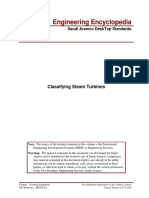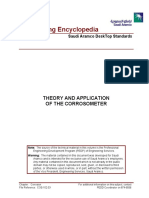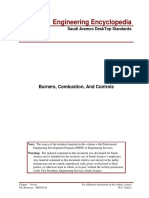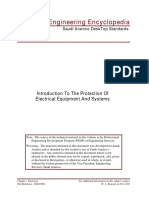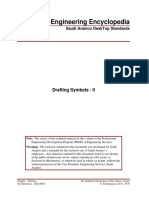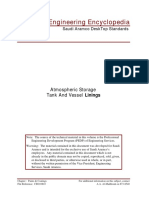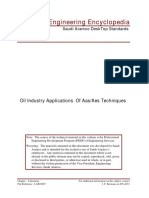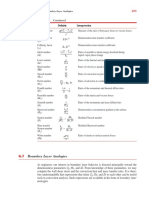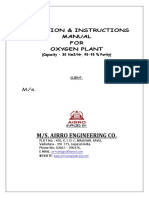Engineering Encyclopedia: Severe Service Control Valve Specification Issues
Engineering Encyclopedia: Severe Service Control Valve Specification Issues
Uploaded by
cvg ertdCopyright:
Available Formats
Engineering Encyclopedia: Severe Service Control Valve Specification Issues
Engineering Encyclopedia: Severe Service Control Valve Specification Issues
Uploaded by
cvg ertdOriginal Description:
Original Title
Copyright
Available Formats
Share this document
Did you find this document useful?
Is this content inappropriate?
Copyright:
Available Formats
Engineering Encyclopedia: Severe Service Control Valve Specification Issues
Engineering Encyclopedia: Severe Service Control Valve Specification Issues
Uploaded by
cvg ertdCopyright:
Available Formats
Engineering Encyclopedia
Saudi Aramco DeskTop Standards
Severe Service Control
Valve Specification Issues
Note: The source of the technical material in this volume is the Professional
Engineering Development Program (PEDP) of Engineering Services.
Warning: The material contained in this document was developed for Saudi
Aramco and is intended for the exclusive use of Saudi Aramco’s
employees. Any material contained in this document which is not
already in the public domain may not be copied, reproduced, sold, given,
or disclosed to third parties, or otherwise used in whole, or in part,
without the written permission of the Vice President, Engineering
Services, Saudi Aramco.
Chapter : Instrumentation For additional information on this subject, contact
File Reference: PCI20401 E. W. Reah on 875-0426
Engineering Encyclopedia Instrumentation
Severe Service Control Valve Specification Issues
CONTENTS PAGES
CONTROL VALVE SERVICE CATEGORIES .............................................................................1
Introduction .......................................................................................................................1
General Service ..................................................................................................................1
General Service Applications ...............................................................................1
General Service Control Valves ...........................................................................1
Severe Service....................................................................................................................2
Severe Service Applications.................................................................................2
Severe Service Control Valves ............................................................................2
Super-Severe Service .........................................................................................................3
Super-Severe Service Applications ......................................................................3
Super-Severe Service Control Valves...................................................................3
Course Focus .....................................................................................................................4
SEVERE SERVICE BOUNDARY CRITERIA ..............................................................................5
Introduction .......................................................................................................................5
Boundary Criteria As “Flags” ............................................................................................5
Service Conditions ...............................................................................................5
Fluid Characteristics.............................................................................................6
Specific Applications ...........................................................................................7
Valve Constructions .............................................................................................8
THE IMPORTANCE OF PROPER CONTROL VALVE SPECIFICATION .................................9
Review Of The Saudi Aramco Selection And Procurement Process..................................9
Specification.......................................................................................................10
Procurement .......................................................................................................10
Saudi Aramco DeskTop Standards
Engineering Encyclopedia Instrumentation
Severe Service Control Valve Specification Issues
Impact Of Errors In The Selection And Procurement Process .........................................11
Opportunities For Errors ....................................................................................11
Courses Of Action To Compensate For Selection Errors ...................................11
Preventing Valve Performance Problems ...........................................................13
Critical Steps In Valve Selection And Sizing...................................................................14
Introduction........................................................................................................14
Verification Of Process Data ..............................................................................15
Initial Valve Selection ........................................................................................15
Initial Valve Sizing.............................................................................................15
Final Selection And Sizing.................................................................................15
Specification On The ISS ...................................................................................15
GLOSSARY ..................................................................................................................................16
Saudi Aramco DeskTop Standards
Engineering Encyclopedia Instrumentation
Severe Service Control Valve Specification Issues
CONTROL VALVE SERVICE CATEGORIES
Introduction
The objective of differentiating between general, severe, and super severe services is to ensure that every valve
that is specified receives the appropriate amount of engineering attention. By providing engineering attention
that is commensurate with the severity of the application, the specifier may prevent operational problems and
costly valve and process failures.
General Service
General Service Applications
General services are those in which the fluids are reasonably clean, inlet pressures and pressure drops are low,
and operating temperatures are less than 400 degrees F. Refer to Figure 1.
General Service Control Valves
General service control valves are those with standard trim, standard materials of construction, and standard
ANSI class ratings below ANSI Class 600. General service valves are “off the shelf” assemblies; i.e., they are
listed as standard products in manufacturer’s catalogs. Refer to Figure 1. As shown in Figure 4, approximately
70 percent of the control valves in Saudi Aramco operations are classified as general service control valves.
General Service Applications General Service Control Valves
General Service Conditions General Service Construction
Moderate Temperatures and Pressures Standard Constructions
Clean Fluids Standard Trim
Moderate Pressure Drops Standard Materials
General Service Applications General Service Valve
Plant Utility Applications Use Word 6.0c or later to
Fuel gas control
Low pressure water, air, and steam
view Macintosh picture.
Typical General Service Valve
Figure 1
General Service Applications And General Service Control Valves
Saudi Aramco DeskTop Standards 1
Engineering Encyclopedia Instrumentation
Severe Service Control Valve Specification Issues
Severe Service
Severe Service Applications
Severe service applications are those in which the fluid is corrosive, erosive, or at an elevated temperature. In
addition, applications with pressure drops that are large enough to cause cavitation, flashing, and the generation
of unacceptable levels of noise are categorized as severe service applications.
Severe Service Control Valves
Severe service control valves include “standard options” for trim and materials of construction that have been
made available to ensure good valve performance and long service life in specific severe service applications.
The term “standard option” refers to an option that is readily available from a valve manufacturer without
special engineering. Refer to Figure 2. As shown in Figure 4, approximately 28 percent of all control valves in
Saudi Aramco operations are classified as severe service control valves.
Severe Service Applications Severe Service Control Valves
Severe Service Conditions Severe Service Construction
Corrosive fluids Special valve constructions
Erosive fluids Special trim designs
High temperature Non-standard materials
Flashing Non-standard accessories
Cavitating
Excessive noise
Typical Severe Applications Example Severe Service Valve
Separator dump
Water injection Use Word 6.0c or later to
Amine letdown
Boiler feedwater
Glycol stripping view Macintosh picture.
Vents
Wellhead choke
Pump recycle
Surge control
Typical Anti-Cavitation Valve Trim
Figure 2
Severe Service Applications And Severe Service Control Valves
Saudi Aramco DeskTop Standards 2
Engineering Encyclopedia Instrumentation
Severe Service Control Valve Specification Issues
Super-Severe Service
Super-Severe Service Applications
Super-severe services are those in which the fluid characteristics are very demanding, the service conditions are
extreme, or when multiple severe conditions are present. For example, if an application involves a fluid that is
highly corrosive, highly erosive, and cavitating, the application is super-severe.
Super-Severe Service Control Valves
Super-severe service control valves are custom constructions - often one-of-a-kind - for which the body design,
trim design, and/or construction materials have been custom-engineered by the valve manufacturer to satisfy the
requirements of a specific, highly demanding application. Refer to Figure 3. As shown in Figure 4, only 2
percent of all control valves in Saudi Aramco operations are classified as super-severe service control valves.
Super-Severe Service Applications Super-Severe Service Control Valves
Super-Severe Service Conditions Super-Severe Valve Construction
Intense conditions Unique designs
Combinations of severe conditions Considerable engineering input
(See Figure 2)
Typical Super-Severe Service Applications Example Super-Severe Service Valve
Water Iijection (seawater/brine) Use Word 6.0c or later to
Wellhead choke
view Macintosh picture.
Special Valve For Extreme Cavitation
Figure 3
Super-Severe Service Applications And Super-Severe Service Control Valves
Saudi Aramco DeskTop Standards 3
Engineering Encyclopedia Instrumentation
Severe Service Control Valve Specification Issues
Use Word 6.0c or later to
view Macintosh picture.
Figure 4
Percentage Of Control Valves In Each Service Category Within Saudi Aramco
Course Focus
This Course will focus on severe-service applications. The reasoning for this focus is explained as follows:
1. Most super-severe applications provide highly visible clues that signal the need for careful engineering
attention; accordingly, super severe-applications do typically receive adequate engineering attention.
2. Most general service applications, by definition, do not present significant problems in valve selection
and sizing.
3. Most specification errors occur because of a failure to distinguish between general and severe service
applications.
Because of the common failure to distinguish between general and severe services, this Course will focus
severe services and related issues.
Saudi Aramco DeskTop Standards 4
Engineering Encyclopedia Instrumentation
Severe Service Control Valve Specification Issues
SEVERE SERVICE BOUNDARY CRITERIA
Introduction
Because of the importance of identifying severe service applications during control valve selection, it is useful
to identify some of the criteria that define the boundaries between general and severe service applications.
Boundary Criteria As “Flags”
The boundary criteria can be viewed as "flags" to indicate that additional engineering attention and
documentation may be required during the valve specification process. The severe service flags that will be
discussed in this section fall into one of the following categories:
• Service Conditions
• Fluid Characteristics
• Specific Applications
• Valve Constructions
Service Conditions
Differential Pressure Limitations - Large pressure drops can signal the potential for flashing,
cavitation, excessive noise, and erosion from high velocity flows. One subjective method for
estimating the pressure drop at which valve problems may occur is expressed as follows:
1000
,
Maximum ∆P, psid ≥ (where D = the nominal valve size in inches)
D
Fluid Temperature Above 400 Degrees F Or Below -20 Degrees F - This is a firm guideline that
signals the need for special materials of construction.
Services Where Cavitation Index Ksa Is > 90% Of Kc - This is a guideline that signals that the
potential for cavitation damage is significant. The terms Ksa and Kc will be defined later in this
Course.
Services Where Cavitation Index Ksa > .80 - This is a guideline that signals a high potential for
cavitation.
Dry Gas And Superheated Steam At Velocities > .25 Mach - Fluid velocities in this range are often
associated with erosion.
Wet Vapor And Saturated Steam At Velocities >.15 Mach - As compared to dry gas and
superheated steam, wet vapors can cause erosion damage at much lower velocities. The increased
potential for damage is caused by the presence of vapor particles that can impinge on critical valve
components.
Saudi Aramco DeskTop Standards 5
Engineering Encyclopedia Instrumentation
Severe Service Control Valve Specification Issues
P1/P2 > 5 For Dry Gas And Superheated Steam Services - P1/P2 ratios in this range can signal the
potential for high-velocity and erosion damage as well as high levels of aerodynamic noise.
P1/P2 > 3 For Wet Vapor, Saturated Steam, And Gas Or Vapor With Entrained Particulates -
Vapors, steam, and fluids with entrained particles are typically controlled at reduced velocities to
minimize the potential for erosion damage.
Control Valve Inlet Velocities In Excess Of 0.3 Meters/Second - Valve inlet velocities in this
approximate range can lead to the generation of excessive noise and erosion damage.
Cavitating Fluids - Fluids that are known to be cavitating present the potential for rapid and total
valve failure of standard control valve constructions.
SPL Limitations (Noise) - Valve generated noise levels above 110 dBA will cause valve damage and
noise levels above 90 dBA will cause hearing loss in workers who are exposed to the noise for
extended periods.
Fluid Characteristics
Corrosive Fluids - Many fluids cause corrosion damage to “standard” control valve materials such as
316 and 416 stainless steels and WCB body castings. The need for special materials signals a severe
service consideration.
Erosive Fluids - Fluids with entrained particles, dirt, sand, or other debris always present the potential
for erosion damage to critical control valve components.
Flashing Services With Downstream Vapor Content > 5% By Weight - Liquids that vaporize as
they pass through the valve increase the potential for erosion damage because the vapor droplets can
impinge at high velocity on critical valve surfaces.
Two-Phase Flow Services With Downstream Vapor Content > 5% By Weight - The concern for
two phase (liquid/gas) flow is the erosion that can result from the high-velocity impingement of
particles on critical surfaces.
Saudi Aramco DeskTop Standards 6
Engineering Encyclopedia Instrumentation
Severe Service Control Valve Specification Issues
Specific Applications
Valves Used For Anti-Surge Control - Control valves in compressor surge control applications are
required to respond very quickly to changes in the control signal, and to provide very short stop-to-
stop stroking times. Special instrumentation is often required to achieve the required performance.
Valves Used For Recycle - Control valves in pump recycle applications are required to respond
quickly to operating transients in a hard (liquid) system. Special instrumentation is often required to
achieve the required performance.
Well-Head Choke Valves - While special choke valves are typically selected for this application,
control valves are occasionally specified. High inlet pressures, high pressure drops, corrosion, erosion,
and combinations of cavitation, flashing, and outgassing combine to form a particularly challenging
application.
Water Injection Services - Water injection is a challenging application because large pressure drops
increase the potential for cavitation, sour water and/or brine solutions are highly corrosive, and
entrained sand and dirt can cause extreme erosion.
Boiler Feedwater Service - Boiler feedwater valves control water at high pressure drops and low flow
rates. Severe cavitation is nearly always expected. In addition, additives such as amines that are used to
treat the water can cause rapid corrosion of components unless the appropriate materials are selected.
Condensate Drain Service - Depending on the application, condensate drain valves may be subjected
to erosion (caused by entrained particles ranging from rocks and sand to vapor particles), corrosion (by
treated fluids or sour fluids), and flashing and cavitation (which result from large pressure drops).
Saudi Aramco DeskTop Standards 7
Engineering Encyclopedia Instrumentation
Severe Service Control Valve Specification Issues
Valve Constructions
ANSI Class Over 600 - An application that requires a control valve body rating above ANSI 600 is
one which is operating at high pressure, high temperature, or both.
Body Size Over 16-Inch - Because the effects of fluid forces do not always scale in a linear fashion
from small to large valve sizes, large valves can present some unusual problems. For example, local
areas of high and low pressure around the valve plug can cause valve plug instability in large valves
that is not generally observed in smaller valves. Non-linear scaling effects have also been documented
for cavitating fluids.
Valve Body Materials Other Than Carbon Steel - A valve specification that includes a non-standard
body material can be interpreted as a signal that corrosion, erosion, flashing, cavitation, or high-
temperatures have been identified as a concern.
Special Actuator Requirements (Short Or Long Response Time) - Many applications have specific
requirements for control valve stroking times. The specified time may be short, as in recycle and surge
control applications, or it may be long, which is often the case when the objective is to prevent pipeline
surge and water hammer.
Saudi Aramco DeskTop Standards 8
Engineering Encyclopedia Instrumentation
Severe Service Control Valve Specification Issues
THE IMPORTANCE OF PROPER CONTROL VALVE SPECIFICATION
Review Of The Saudi Aramco Selection And Procurement Process
Because most control valve problems can be traced to an error or omission in the selection and procurement
process, it will be helpful to review the selection and procurement processes as implemented at Saudi Armaco.
Refer to Figure 5 and the discussion that follows.
Use Word 6.0c or later to
view Macintosh picture.
Figure 5
Overview Of The Saudi Aramco Valve Selection And Procurement Processes
Saudi Aramco DeskTop Standards 9
Engineering Encyclopedia Instrumentation
Severe Service Control Valve Specification Issues
Specification
Acquisition Of Process Data - In order to select and size a control valve, the specifier must first obtain
all pertinent process data; i.e., the fluid characteristics, the fluid physical properties, and the service
conditions (operating pressures, pressure drops, flow rates, and temperatures).
Initial Valve Selection From Fluid Characteristics - The initial selection of a particular valve type
and various options is typically based on an analysis of the fluid characteristics; whether or not the
fluid is corrosive, erosive, or at high temperature.
Initial Valve Sizing - The initial sizing calculations are performed to determine the valve size and to
allow the specifier to ensure that the preferred valve style is available in the needed size. The
calculations should also reveal the presence of choked flow, flashing, cavitation, and whether or not
excessive levels of noise will be generated.
Final Selection And Sizing - After the specifier is satisfied that the initially selected valve type and
size are satisfactory for the application, minor corrections and modifications may be made to account
for valve availability, material requirements, installation details, actuator and accessory selection, and
other specification issues.
Specification On The Saudi Aramco ISS - To develop a formal specification, the specifier finally
enters all specification data on the Saudi Aramco ISS (Instrument Specification Sheet).
Procurement
Request For Quote - The control valve specification is forwarded to the Saudi Aramco procurement
division where it is distributed to control valve vendors as a request for quote (RFQ). The result to
Saudi Armaco may be a low first cost; however, the installed cost (product life cost) may be very high
because of poor control valve performance and/or premature valve failure.
Technical Review - When the quotes are received from the valve vendors, they are reviewed to ensure
that the quoted control valves conform to the specifications on the ISS. Vendors who submit quotes
will be influenced by two competing objectives: (1) winning the bid award, and (2) providing the best
control valve for the application. Vendor’s commercial interests are very strong and it is not
uncommon for a vendor to quote a low-cost, general service valve into a severe service application for
the purpose of winning the bid award. During the technical review, it may be difficult to defend the
selection of a superior control valve if there are many bids for lower cost control valves.
Saudi Aramco DeskTop Standards 10
Engineering Encyclopedia Instrumentation
Severe Service Control Valve Specification Issues
Commercial Review - Vendors and manufacturers must also pass a commercial review to ensure that
they are in compliance with Saudi Aramco standards that address manufacturing standards, quality
control, documentation requirements, and various other business issues.
Final Selection: Low Bid - The objective of Saudi Aramco’s procurement division is to acquire the
needed products and services at the lowest possible cost to the company. Accordingly, the contract or
purchase order is awarded to the vendor who has submitted the lowest bid.
Impact Of Errors In The Selection And Procurement Process
Opportunities For Errors
There are many steps in the selection and procurement process. As a result, there are many opportunities for
error.
Specification Errors - Errors can occur in the specification process as a result of failing to identify
severe service conditions, failing to select an appropriate valve, or failing to accurately document the
specification on the ISS.
Procurement Errors - Errors in the procurement process include failure to interpret the requirements
on the ISS and placing an undue emphasis on the criterion of low cost.
Courses Of Action To Compensate For Selection Errors
Any error in the selection and procurement process will become most visible in the performance of the valve
after it is installed. The valve may provide poor performance, it may provide a short service life, or it may
totally fail upon installation. As shown in Figure 6, there are several courses of action that can be taken when a
valve provides less than acceptable performance.
Saudi Aramco DeskTop Standards 11
Engineering Encyclopedia Instrumentation
Severe Service Control Valve Specification Issues
Use Word 6.0c or later to
view Macintosh picture.
Figure 6
Courses Of Action To Compensate For Selection Errors
Saudi Aramco DeskTop Standards 12
Engineering Encyclopedia Instrumentation
Severe Service Control Valve Specification Issues
Enduring Poor Performance - The simplest course of action is to do nothing. This option is possible
only if the installed valve provides some measure of control. However, enduring poor performance can
have significant impact on the quality of process control, the quality of the product that is being
produced, downstream processes, and the overall economy and efficiency of the process.
Retrofit/Upgrade - Retrofits and upgrades such as replacing trim, replacing actuators, and other
“fixes” require additional expense, additional engineering resources, and often require costly process
downtime.
Scrap And Replace - If the installed valve proves to be entirely unsatisfactory, it must be replaced.
Replacement results in a duplication of all efforts in selection, procurement, and installation and typical
requires significant process downtime.
Preventing Valve Performance Problems
Because of the high costs of dealing with a control valve failure, it is clearly preferable to take the steps that are
necessary to ensure that an appropriate control valve will be selected. The specifier’s last opportunity to prevent
the selection of a less than adequate control valve is during the preparation of the control valve specification.
Saudi Aramco DeskTop Standards 13
Engineering Encyclopedia Instrumentation
Severe Service Control Valve Specification Issues
Critical Steps In Valve Selection And Sizing
Introduction
To ensure that the valve specification is accurate and complete, additional engineering attention must be applied
at several critical points in the valve selection and sizing process. Refer to Figure 7 and the discussion that
begins on the following page.
Use Word 6.0c or later to
view Macintosh picture.
Figure 7
Critical Steps In Control Valve Selection And Sizing
Saudi Aramco DeskTop Standards 14
Engineering Encyclopedia Instrumentation
Severe Service Control Valve Specification Issues
Verification Of Process Data
Documentation Vs. Actual Operating Conditions - In many instances, the valve specifier is
presented with process data that describes the fluid, fluid properties, and service conditions. There are
many sources of such data; e.g., original piping diagrams and design documents. However, the
available information may not accurately describe the as-operated conditions. For example,
undocumented changes in system parameters may have been made, upstream or downstream pressures
and flow rates may have changed due to a change in piping or pipeline equipment, or the system may
be operating at reduced capacity or increased capacity.
Information Sources - Accurate and up-to-date process and fluid data may be obtained from updated
process diagrams and/or by contacting operations personnel, maintenance personnel, SA process
personnel, or CSD consultants.
Initial Valve Selection
The best time to identify corrosive applications, erosive applications, or high temperature applications is during
the initial valve selection step. These severe service conditions can be identified from a description of the fluid,
the fluid characteristics, and the service conditions.
Initial Valve Sizing
During this step, the specifier is examining the fluid properties and service conditions (flow, velocity, and
pressure conditions) for the purpose of sizing the valve. Because the severe service conditions of cavitation,
flashing, and excessive noise can also be determined from the fluid properties and the service conditions, this is
the appropriate time to apply additional engineering attention to determine if these severe service conditions are
present.
Final Selection And Sizing
During the final selection and sizing step, it is incumbent on the specifier to integrate all of the normal
requirements of capacity, flow characteristics, etc. plus the severe service requirements into the valve
specification.
Specification On The ISS
After a satisfactory valve construction has been identified, it must be accurately specified (clearly documented)
on the ISS. If the control valve specification is complete and precise, there is little opportunity for error in the
downstream processes; i.e., vendors will be forced to submit quotes for acceptable valves , and quotes for
unacceptable valves will be identified during the technical review.
Saudi Aramco DeskTop Standards 15
Engineering Encyclopedia Instrumentation
Severe Service Control Valve Specification Issues
GLOSSARY
∆P The pressure drop across the valve; P 1-P2 in psid.
cavitation The potentially damaging formation and collapse of vapor bubbles that
occurs when the pressure at the valve vena contracta (P vc) falls below the
fluid vapor pressure (Pv) and pressure P2 is greater than the fluid vapor
pressure.
corrosion The removal of material through various chemical attack mechanisms.
erosion The removal of material through various physical attack mechanisms.
flashing The flowstream phenomenon of fluid vaporization and increased fluid
velocity that occurs when the pressure at the vena contracta (P vc) falls
below the fluid vapor pressure (Pv) and the downstream pressure (P2) is
greater than the fluid vapor pressure.
general service A service that is categorized by clean fluids, moderate pressures,
moderate pressure drops, and fluid temperatures below 400 degrees F.
high-temperature Any application that operates at a temperature that is greater than 400
application degrees F.
ISS Instrument Specification Sheet; the Saudi Aramco engineering
document that is used to prepare a control valve specification.
Ksa An index that describes, on a scale from 0 to 100, the relative potential
for cavitation in a given system; calculated as the ratio of the pressure
drop across the valve (P1-P2) to the value of P1-Pv.
severe service A service in which the fluid is corrosive, erosive, flashing, cavitating at
high temperature, and/or one at sufficient velocity to generate excessive
noise.
SPL Sound pressure level.
super-severe service A service that is characterized by extremely difficult fluids, extreme
pressures, pressure drops, or fluid temperature, or combinations of
severe conditions.
two-phase flow A flow that consists of fluids in two different states; e.g., a liquid and its
vapor or a liquid and a gas.
Saudi Aramco DeskTop Standards 16
You might also like
- Sabp G 012Document13 pagesSabp G 012Erol DAĞNo ratings yet
- Sabp A 001Document22 pagesSabp A 001kuse2456No ratings yet
- Proper Steam Turbine OperationDocument32 pagesProper Steam Turbine OperationBalasubramanian C100% (2)
- Ups 3Document32 pagesUps 3abdulkadhir100% (1)
- 17 Samss 006Document13 pages17 Samss 006Ahamedulla KhanNo ratings yet
- AGE10503, Gas ProcessingDocument34 pagesAGE10503, Gas ProcessingiranmortezaNo ratings yet
- Mex 21307Document30 pagesMex 21307Yousef Adel HassanenNo ratings yet
- PCI20107, Overview of Boiler Commissioning and Startup PDFDocument17 pagesPCI20107, Overview of Boiler Commissioning and Startup PDFMarc AnmellaNo ratings yet
- Specifying Control ValvesDocument298 pagesSpecifying Control ValvesAriyandi Yuda PraharaNo ratings yet
- Engineering Encyclopedia: Saudi Aramco Desktop StandardsDocument12 pagesEngineering Encyclopedia: Saudi Aramco Desktop StandardsFA Ay100% (1)
- Mex 21301Document47 pagesMex 21301Yousef Adel Hassanen100% (1)
- Engineering Encyclopedia: Reciprocating CompressorsDocument30 pagesEngineering Encyclopedia: Reciprocating CompressorsLogeswaran Appadurai100% (1)
- EEX10401 Industrial Facility SubstationDocument64 pagesEEX10401 Industrial Facility SubstationHonesto Bautista100% (1)
- EEX 107.06 Evaluating Voltage Excitation TestsDocument37 pagesEEX 107.06 Evaluating Voltage Excitation TestsJellyn Base100% (1)
- Eex10506 Fund of Hazardous LocationsDocument52 pagesEex10506 Fund of Hazardous LocationsHonesto BautistaNo ratings yet
- Engineering Encyclopedia Saudi Aramco DeskTop Standards Cooling Water TreatmentDocument56 pagesEngineering Encyclopedia Saudi Aramco DeskTop Standards Cooling Water TreatmentismaelarchilacastilloNo ratings yet
- Mex 30204Document26 pagesMex 30204Yousef Adel HassanenNo ratings yet
- Engineering Encyclopedia: Distillation ProcessDocument70 pagesEngineering Encyclopedia: Distillation ProcessLogeswaran AppaduraiNo ratings yet
- Mex 21305Document39 pagesMex 21305Yousef Adel Hassanen100% (1)
- Saep 1636Document10 pagesSaep 1636Branko_62No ratings yet
- Mex 21303Document93 pagesMex 21303Yousef Adel HassanenNo ratings yet
- Engineering Encyclopedia: Instrumented ScrapersDocument16 pagesEngineering Encyclopedia: Instrumented ScrapersabyNo ratings yet
- Best Practice: Load Management For Energy Efficiency: Heat Transfer EquipmentDocument75 pagesBest Practice: Load Management For Energy Efficiency: Heat Transfer Equipmentsethu1091No ratings yet
- PMT 10305Document30 pagesPMT 10305Yousef Adel HassanenNo ratings yet
- Engineering Encyclopedia: Data NetworksDocument54 pagesEngineering Encyclopedia: Data NetworksLogeswaran AppaduraiNo ratings yet
- Engineering Encyclopedia: Miscellaneous Mechanical ComponentsDocument36 pagesEngineering Encyclopedia: Miscellaneous Mechanical ComponentsLogeswaran AppaduraiNo ratings yet
- Theory and Application of The CorrosometerDocument19 pagesTheory and Application of The CorrosometerAnonymous S9qBDVkyNo ratings yet
- Cte10109 PDFDocument18 pagesCte10109 PDFcvg ertdNo ratings yet
- Selecting Low Voltage Motor StartersDocument114 pagesSelecting Low Voltage Motor StartersJellyn BaseNo ratings yet
- Engineering Encyclopedia Saudi AramcoDocument83 pagesEngineering Encyclopedia Saudi AramcoMANUEL JESÚS GÓMEZ GARCÍA100% (2)
- Engineering Encyclopedia: Combustion Gas TurbinesDocument30 pagesEngineering Encyclopedia: Combustion Gas TurbinesLogeswaran AppaduraiNo ratings yet
- Mex 30210Document43 pagesMex 30210Yousef Adel HassanenNo ratings yet
- Eex10601 PDFDocument29 pagesEex10601 PDFcvg ertd100% (1)
- Engineering Encyclopedia: Instrument TransformersDocument30 pagesEngineering Encyclopedia: Instrument Transformerscvg ertd100% (1)
- Engineering Encyclopedia: Fabrication, Inspection, and Testing of Heat ExchangersDocument31 pagesEngineering Encyclopedia: Fabrication, Inspection, and Testing of Heat ExchangersAfzaalUmair100% (1)
- Electric Motor 8Document114 pagesElectric Motor 8abdulkadhir0% (1)
- Specification of TransformerDocument43 pagesSpecification of TransformerJaaffer AliNo ratings yet
- Engineering Encyclopedia: Pumps and CompressorsDocument191 pagesEngineering Encyclopedia: Pumps and CompressorsReda100% (2)
- CHE10705, Steam Generation andDocument34 pagesCHE10705, Steam Generation andNacer KisyNo ratings yet
- Engineering Encyclopedia: Generator FundamentalsDocument139 pagesEngineering Encyclopedia: Generator FundamentalsCorey Porter100% (2)
- Saep 20Document32 pagesSaep 20OMER ELFADILNo ratings yet
- 34 Samss 122Document13 pages34 Samss 122naruto256No ratings yet
- Mex 21304Document61 pagesMex 21304Yousef Adel Hassanen100% (2)
- Electric Motor 5Document90 pagesElectric Motor 5abdulkadhir100% (1)
- Electric Motor 6Document20 pagesElectric Motor 6abdulkadhir100% (1)
- Engineering Encyclopedia: Mass and Energy Balance Preparation and UseDocument33 pagesEngineering Encyclopedia: Mass and Energy Balance Preparation and UseLogeswaran AppaduraiNo ratings yet
- EEX 107.07 Fundamentals of Cable Fault LocalizationDocument28 pagesEEX 107.07 Fundamentals of Cable Fault LocalizationJellyn Base100% (1)
- 23 Samss 020Document44 pages23 Samss 020Cherukunnon Jubu100% (1)
- Age 10802Document162 pagesAge 10802vinoratheeshNo ratings yet
- Aramco Engineering - Evaluating Motor SpecificationsDocument161 pagesAramco Engineering - Evaluating Motor Specificationsdeepu220100% (1)
- Electric Motor 9Document54 pagesElectric Motor 9abdulkadhirNo ratings yet
- PMT 30108Document30 pagesPMT 30108Yousef Adel HassanenNo ratings yet
- Engineering Encyclopedia: Centrifugal CompressorsDocument47 pagesEngineering Encyclopedia: Centrifugal CompressorsLogeswaran AppaduraiNo ratings yet
- Engineering Encyclopedia: Electric MotorsDocument53 pagesEngineering Encyclopedia: Electric MotorsLogeswaran AppaduraiNo ratings yet
- Sabp F 005Document17 pagesSabp F 005Eagle SpiritNo ratings yet
- EEX 107.02 Evaluating Insulation TestsDocument107 pagesEEX 107.02 Evaluating Insulation TestsJellyn Base100% (1)
- PMT 30106Document36 pagesPMT 30106Yousef Adel HassanenNo ratings yet
- Model 5550 HPHT Viscometer ManualDocument72 pagesModel 5550 HPHT Viscometer ManualMalik KNo ratings yet
- FMRC 7710Document14 pagesFMRC 7710berkayNo ratings yet
- Sizing Control Valves - AramcoDocument141 pagesSizing Control Valves - Aramcomohamed gharibNo ratings yet
- Engineering Encyclopedia: Exxon Chemical and Mechanical Cleaning Manual 12) Fouling Control by PrepassivationDocument9 pagesEngineering Encyclopedia: Exxon Chemical and Mechanical Cleaning Manual 12) Fouling Control by Prepassivationcvg ertdNo ratings yet
- Nuovo Pignone: Gas Turbine Compressor WashingDocument22 pagesNuovo Pignone: Gas Turbine Compressor Washingcvg ertdNo ratings yet
- Engineering Encyclopedia: Fundamental of Radio CommunicationsDocument12 pagesEngineering Encyclopedia: Fundamental of Radio Communicationscvg ertdNo ratings yet
- Engineering Encyclopedia: Atmospheric Storage Tank and Vessel LiningsDocument18 pagesEngineering Encyclopedia: Atmospheric Storage Tank and Vessel Liningscvg ertdNo ratings yet
- Engineering Encyclopedia: Oil Industry Applications of Aas/Aes TechniquesDocument16 pagesEngineering Encyclopedia: Oil Industry Applications of Aas/Aes Techniquescvg ertdNo ratings yet
- Coe10508 PDFDocument25 pagesCoe10508 PDFcvg ertdNo ratings yet
- Data Sheet RVO 07011Document2 pagesData Sheet RVO 07011cvg ertd100% (1)
- Engineering Encyclopedia: Telephone SwitchingDocument19 pagesEngineering Encyclopedia: Telephone Switchingcvg ertdNo ratings yet
- Engineering Encyclopedia: Maintenance Paint and Protective Coating SurveysDocument24 pagesEngineering Encyclopedia: Maintenance Paint and Protective Coating Surveyscvg ertdNo ratings yet
- Eex10601 PDFDocument29 pagesEex10601 PDFcvg ertd100% (1)
- Engineering Encyclopedia: Environmental ComplianceDocument25 pagesEngineering Encyclopedia: Environmental Compliancecvg ertdNo ratings yet
- Engineering Encyclopedia: Exxon Chemical and Mechanical Cleaning Manual 6) Precommission Cleaning and PassivationDocument14 pagesEngineering Encyclopedia: Exxon Chemical and Mechanical Cleaning Manual 6) Precommission Cleaning and Passivationcvg ertdNo ratings yet
- Engineering Encyclopedia: Structural Steel Codes and StandardsDocument23 pagesEngineering Encyclopedia: Structural Steel Codes and Standardscvg ertdNo ratings yet
- Data Sheet Som 14463 PDFDocument2 pagesData Sheet Som 14463 PDFcvg ertdNo ratings yet
- Engineering Encyclopedia: Lab Experiments in IcpDocument21 pagesEngineering Encyclopedia: Lab Experiments in Icpcvg ertdNo ratings yet
- ZFOD-Zubair Field Op - DivDocument6 pagesZFOD-Zubair Field Op - Divcvg ertdNo ratings yet
- Engineering Encyclopedia: Introduction To Environmental AwarenessDocument21 pagesEngineering Encyclopedia: Introduction To Environmental Awarenesscvg ertdNo ratings yet
- Engineering Encyclopedia: Exxon Chemical and Mechanical Cleaning Manual 20) Planning and Control of A Cleaning JobDocument14 pagesEngineering Encyclopedia: Exxon Chemical and Mechanical Cleaning Manual 20) Planning and Control of A Cleaning Jobcvg ertdNo ratings yet
- Engineering Encyclopedia: Basic Radio SystemsDocument16 pagesEngineering Encyclopedia: Basic Radio Systemscvg ertdNo ratings yet
- Engineering Encyclopedia: Exxon Chemical and Mechanical Cleaning Manual 12) Fouling Control by PrepassivationDocument9 pagesEngineering Encyclopedia: Exxon Chemical and Mechanical Cleaning Manual 12) Fouling Control by Prepassivationcvg ertdNo ratings yet
- Engineering Encyclopedia: Protective Coatings For Corrosion Prevention Beneath Thermal Insulation and ConcreteDocument23 pagesEngineering Encyclopedia: Protective Coatings For Corrosion Prevention Beneath Thermal Insulation and Concretecvg ertdNo ratings yet
- Cte10109 PDFDocument18 pagesCte10109 PDFcvg ertdNo ratings yet
- Engineering Encyclopedia: Telephone Support ServicesDocument12 pagesEngineering Encyclopedia: Telephone Support Servicescvg ertdNo ratings yet
- ZFOD-Zubair Field Op - DivDocument4 pagesZFOD-Zubair Field Op - Divcvg ertdNo ratings yet
- ZFOD-Zubair Field Op - DivDocument6 pagesZFOD-Zubair Field Op - Divcvg ertdNo ratings yet
- Engineering Encyclopedia: Atmospheric Storage Tank and Vessel LiningsDocument18 pagesEngineering Encyclopedia: Atmospheric Storage Tank and Vessel Liningscvg ertdNo ratings yet
- Engineering Encyclopedia: Fundamental of Radio CommunicationsDocument12 pagesEngineering Encyclopedia: Fundamental of Radio Communicationscvg ertdNo ratings yet
- Tuning Anti-Surge Controllers: Safety Features in ManualDocument6 pagesTuning Anti-Surge Controllers: Safety Features in Manualcvg ertd100% (2)
- Engineering Encyclopedia: Instrument TransformersDocument30 pagesEngineering Encyclopedia: Instrument Transformerscvg ertd100% (1)
- 1237-1 Possible Flexible Hose Installation Errors February 25, 1998Document4 pages1237-1 Possible Flexible Hose Installation Errors February 25, 1998cvg ertdNo ratings yet
- מספרים חסרי מימדDocument1 pageמספרים חסרי מימדA.b Te'enaNo ratings yet
- Dwight Barkley, 2015, The Rise of Fully Turbulent FlowDocument14 pagesDwight Barkley, 2015, The Rise of Fully Turbulent FlowZiying FangNo ratings yet
- MECHANICAL SEPARATIONS Transport Phenomena and Unit Operations A Combined Approach-Richard G. GriskeyDocument43 pagesMECHANICAL SEPARATIONS Transport Phenomena and Unit Operations A Combined Approach-Richard G. GriskeyMarco Antonio FeriaNo ratings yet
- Falling Ball Viscometer: Abhishek Suman Department of Energy Science and Engineering IIT BombayDocument12 pagesFalling Ball Viscometer: Abhishek Suman Department of Energy Science and Engineering IIT BombayPratham sehgalNo ratings yet
- Southern Cross 125 X 80 - 200Document1 pageSouthern Cross 125 X 80 - 200supriNo ratings yet
- Asco TodasDocument36 pagesAsco TodasEduardo Landa GonzalezNo ratings yet
- CATALOGO MINI SPLIT INVERTER SEER 18 McQUAYDocument2 pagesCATALOGO MINI SPLIT INVERTER SEER 18 McQUAYLUIS JIMENEZNo ratings yet
- List of Dams and Reservoirs in Maharashtra - WikipediaDocument16 pagesList of Dams and Reservoirs in Maharashtra - WikipediaGaurav DeshmukhNo ratings yet
- Coagulation/ Flocculation For Wastewater Treatment: I N Dustrial Wa Ste & Ma N Agement Con T RolDocument27 pagesCoagulation/ Flocculation For Wastewater Treatment: I N Dustrial Wa Ste & Ma N Agement Con T RolKyle Dela CruzNo ratings yet
- Radiation (Exam)Document2 pagesRadiation (Exam)Dozdi100% (2)
- M/S. Airro Engineering Co.: Operation & Instructions Manual FOR Oxygen PlantDocument16 pagesM/S. Airro Engineering Co.: Operation & Instructions Manual FOR Oxygen PlantDr Gajanan ShirkeNo ratings yet
- Evaporation Mechanisms in Liquids Cammenga PDFDocument2 pagesEvaporation Mechanisms in Liquids Cammenga PDFLamarNo ratings yet
- System Coupling Heating Coil TutorialDocument32 pagesSystem Coupling Heating Coil TutorialFlyNarutoFly27No ratings yet
- Boiling Point PDFDocument4 pagesBoiling Point PDFCheng Khie ChiehNo ratings yet
- APPENDIX 1-1. Preferred Manufacturers List InstrumentationDocument4 pagesAPPENDIX 1-1. Preferred Manufacturers List InstrumentationMarcos Nava BarbozaNo ratings yet
- 2 - HE 731 - Example - Settling BasinDocument4 pages2 - HE 731 - Example - Settling BasinHa NaNo ratings yet
- Heat Exchanger Types and SelectionDocument4 pagesHeat Exchanger Types and Selection12mchc07No ratings yet
- Butt Fusion Guidelines (PolyPipe)Document40 pagesButt Fusion Guidelines (PolyPipe)Yulius MatarruNo ratings yet
- Bits, Pilani - K. K. Birla Goa Campus: Process Control-CHE C441 Chapter #2Document71 pagesBits, Pilani - K. K. Birla Goa Campus: Process Control-CHE C441 Chapter #2S S S REDDYNo ratings yet
- Rheologica Acta Volume 9 Issue 4 1970 (Doi 10.1007 - bf01985475) N. D. Waters - M. J. King - Unsteady Flow of An Elastico-Viscous Liquid PDFDocument1 pageRheologica Acta Volume 9 Issue 4 1970 (Doi 10.1007 - bf01985475) N. D. Waters - M. J. King - Unsteady Flow of An Elastico-Viscous Liquid PDFSrinivas JangiliNo ratings yet
- Arasains 6th Webinar, Static Mixing Fundamentals and ApplicationsDocument2 pagesArasains 6th Webinar, Static Mixing Fundamentals and ApplicationsiamNo ratings yet
- Pavitra Aur Islam Dharma - Q.S. KhanDocument74 pagesPavitra Aur Islam Dharma - Q.S. KhanNitin PednekarNo ratings yet
- Rev: B PSL: N/A P/N: R70815-1 Test Requirements: EPS R70815-1 Test Procedure: EPS R70815-1 Sqr-Ptt1 Sales Order: Cbr0044Document1 pageRev: B PSL: N/A P/N: R70815-1 Test Requirements: EPS R70815-1 Test Procedure: EPS R70815-1 Sqr-Ptt1 Sales Order: Cbr0044irawatiNo ratings yet
- Asme Sec I PT Peb 2005 PDFDocument4 pagesAsme Sec I PT Peb 2005 PDFarlyNo ratings yet
- Filters For Chicago Pneumatic CPDocument7 pagesFilters For Chicago Pneumatic CPsuraj pandeyNo ratings yet
- DAK 12403 - Exp 5 Head Loss Through FittingsDocument7 pagesDAK 12403 - Exp 5 Head Loss Through FittingsMuiz UdinNo ratings yet
- Chapter 5 - Steam Power Plant ReviewerDocument9 pagesChapter 5 - Steam Power Plant ReviewerKyle YsitNo ratings yet
- CH8701 Process Equipment Design MCQ 1Document3 pagesCH8701 Process Equipment Design MCQ 1Dhananjay PatilNo ratings yet
- Sludge Volume IndexDocument3 pagesSludge Volume IndexNicole Feliciano100% (1)
- CP 502Document9 pagesCP 502Anonymous Zsi5ODm2PYNo ratings yet










